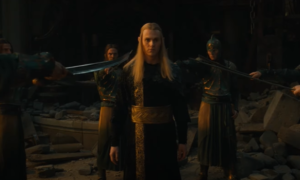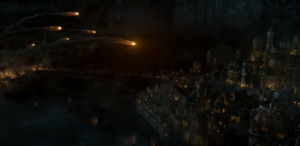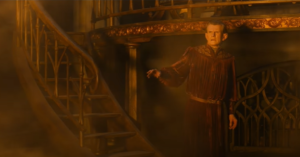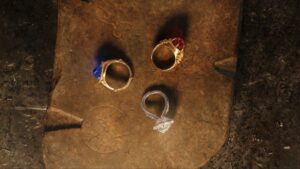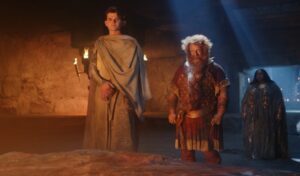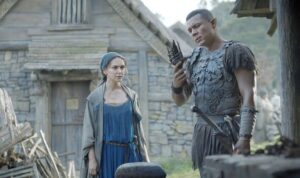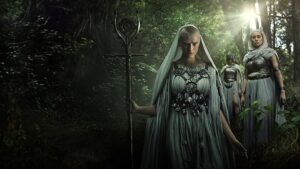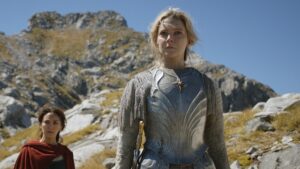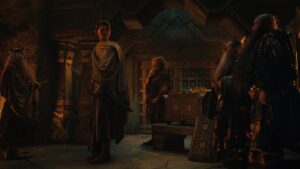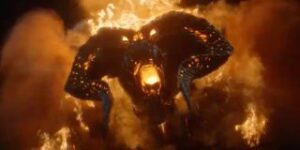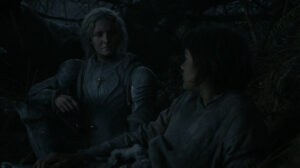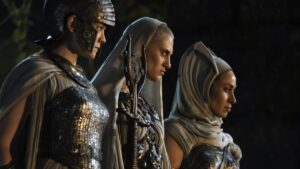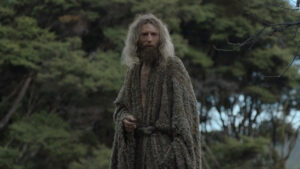POTENTIAL SPOILERS FOR THE RINGS OF POWER SEASON TWO AHEAD!
The Rings Of Power attracts a lot of undue hate, but of all the many criticisms directed at the show in its first season, one with which I think most, if not all, fans would agree is that the forging of the titular Rings and everything leading up to it was handled rather clumsily. While the show was inevitably going to disappoint somebody no matter how it adapted this pivotal moment in Middle-earth’s history for the screen, on account of how many times Sauron’s deception of the great Elven craftsman Celebrimbor, in his “fair form” as Annatar, has been depicted across art, fanfiction, cosplay, and video games, resulting in just as many highly distinct opinions of how these two characters – whose actual appearances and personalities were sketched out in the broadest of strokes by J.R.R. Tolkien – “should” look and interact, it is quite impressive that The Rings Of Power managed to upset basically everybody.

To recap: Sauron, disguised not as Annatar but as a grungy Southland prince named Halbrand, is injured in battle when the Southlands fall to Adar, just badly enough that the Númenórean medics can’t do anything for him, but not so badly that he can’t apparently withstand a journey of a least a month or two on horseback at breakneck speed to the nearest Elven kingdom, Eregion, a thousand miles away. There, Halbrand instantly recovers, wanders seemingly by accident into Celebrimbor’s forge and meets the legendary smith, who is despondent, having failed to produce anything that can prevent the fading of Elvendom – which the Elves have decided is imminent because a tree in Lindon is dying (long story). Halbrand explains to Celebrimbor what an alloy is, at which point Celebrimbor decides to trust this random stranger unreservedly and work with him. But Galadriel grows suspicious of Halbrand and does some digging, discovering that there is no prince of the Southlands. She confronts him privately about her suspicions that he’s actually the Dark Lord Sauron, and thankfully he is, or that’d be really awkward. He leaves Eregion, Galadriel decides not to tell anybody, and a clueless Celebrimbor proceeds with his and Halbrand’s plan to create powerful circular objects out of mithril – but where Halbrand wanted two crowns, one for him and one for Galadriel, Galadriel advises Celebrimbor to make three Rings. And all of that in the final episode of the season, which also had to accommodate a totally isolated subplot involving Harfoots and wizards on the other side of Middle-earth.
Now, I am not a “book purist” by nature, so deviations from the source material do not inherently bother me – as long as they contribute to a better (or at the very least equally compelling) version of the story being told. I have accepted that for the show’s purposes, the Three Rings had to be forged before the Seven and the Nine, and I probably could have gotten over my disappointment that Sauron appeared to Celebrimbor as a mortal man instead of an Elven emissary of the Valar, but I cannot make excuses for the hectic pacing, plot contrivances, and inorganic character beats required to bring everything together in the final few minutes of the season finale. The forging of the Rings neither lives up to expectations nor makes for entertaining, well-crafted television in its own right.
I can’t say I’m surprised, then, that the marketing for season two – culminating in the trailer released at San Diego Comic-Con – has made it very clear that the story of Sauron and Celebrimbor, far from being over, will instead begin anew in the upcoming second season, with Celebrimbor taking on a much larger role and Sauron finally adopting the name and guise of Annatar when he returns to Eregion. I admit to wondering whether this was planned from the outset or a direct response to the first season’s mixed reception, but either way I can guarantee you that some book purists will claim responsibility for the show course-correcting if they deem it a success and insist that the showrunners ignored the fandom entirely if not. Amazon probably doesn’t care as long as they tune in – and they will. Even if they feign morbid curiosity, the chance to endlessly critique the shortcomings of an adaptation promising to adhere closer to J.R.R. Tolkien’s writings is like catnip for some book purists.
And not that you would be able to tell from the comments section under the trailer on YouTube, where miserable internet trolls have shown up to spam the dislike button and scream into the void about Amazon “desecrating” Tolkien’s legacy (I don’t even consider these to be book purists; most have never read the books and only know what they’ve been told by right-wing rage-baiters), but the upcoming season actually looks good. In this post we’ll be going over all the new footage shown at San Diego Comic-Con, as well as a few shots from other teasers and promotional materials Amazon has put out since then that I wouldn’t be able to talk about otherwise. I’m divvying up this breakdown into smaller segments focused on each of the five main storylines: Eregion and Lindon, Khazad-dûm, Númenor, the Southlands, and Rhûn. I’ll do my best to keep spoilers to a minimum even as I try to arrange images from the trailer into chronological order based on my knowledge of the books.
EREGION AND LINDON

For reasons that The Rings Of Power has never felt compelled to elaborate on, the Elves have until next spring to find a cure for a specific tree in Lindon or they will fade, if they do not escape over the sea into the West. Obviously, the idea of Middle-earth slowly becoming uninhabitable for the Elves is an ever-present theme in all of Tolkien’s writings that deal with them: they were meant to live forever in the Undying West, but many of them followed Fëanor to Middle-earth in the First Age and tragically fell in love with a world that was always intended to belong to humans, who would inevitably drive them out. The forging of the Three Rings does indeed constitute the last attempt by the Elves to prevent the doom that awaits them in Middle-earth, but the arbitrary urgent deadline and the magical mood-ring tree are clunky and overly literal means of conveying all of that.
Thankfully, The Rings Of Power will be pressing pause on this storyline by having Galadriel and Elrond arrive in Lindon with the Three Rings in the nick of time to save the tree before it dies. Galadriel isn’t being forthcoming about the fact that Sauron was involved in the creation of the Three, but Elrond (who was already catching on last season that Halbrand wasn’t what he claimed to be) seems to have reservations about the Elves putting on the Rings and probably communicates this to the High King Gil-galad, because we see that in a last resort, as the ceremony is failing and the Rings have fallen useless to the ground, one of them – Nenya – bounces down a flight of steps and comes to a stop in front of Galadriel. The whole sequence evokes how the One Ring made its way deliberately to Bilbo Baggins in the prologue of The Fellowship Of The Ring, and suggests that the Three Rings possess wills of their own. With no other choices left to her, Galadriel picks up the ring, slips it on her finger, and seals her fate.


And with that, I’m sure, the tree will put forth a single fragile leaf and the sky will begin to clear. Gil-galad and Círdan the Shipwright will hastily put on the other two rings, and in a matter of moments, Lindon will be returned to a state of perpetual autumn – not spring or summer, notably, because the Rings can only roll back time so far and winter cannot be held at bay forever. But with the crisis temporarily averted, Gil-galad has bought himself time with which to question Galadriel and Elrond about what went down in Eregion, and Galadriel will be made to reveal the true identity of Halbrand.



Cut to Halbrand, returning to Eregion one dark and stormy night, and being welcomed back into Celebrimbor’s house by the Elven-smith himself. I expect Celebrimbor to be wary of Halbrand at first, as he remembers Galadriel’s vague warning not to engage with the Southlander, but believing him still to be just that, he will make the decision not to turn away his unexpected visitor. After all, Celebrimbor is the Lord of Eregion; how much trouble could one man be? Well, lots – you’d think Celebrimbor would have learned that lesson the hard way from having lived in Nargothrond in the First Age – and of course, Halbrand is no man, but a few red flags can’t stop Celebrimbor. Which…I mean, fair.
In a featurette titled Forging The Rings, we see Halbrand and Celebrimbor discussing the Three Rings while Halbrand dries off by the fire. Celebrimbor asks if they worked, and the response – “They worked wonders” – puts a huge smile on his face. Sauron will probably keep up the pretense for Celebrimbor that he was in Lindon to witness the ceremony, but in truth, I think Sauron is attuned to the Three Rings and can sense when and in what ways they are being used (when worn), even if he cannot tell who’s wearing them.



That same evening, if Celebrimbor’s clothing is anything to go by, Sauron will cast off the disguise of Halbrand and reveal to Celebrimbor that he has been sent by the gods to do for all of Middle-earth’s Free Peoples what he has done for the Elves – and to that end, they must make more Rings of Power. A wide-eyed Celebrimbor, who by this point is mentally forging their wedding-rings for each other, asks for his name, and Sauron, now fair-haired and clean-shaven, replies “a sharer of gifts”; which isn’t an exact translation of Annatar (lord of gifts) but is close enough that I’ll forgive it, even if Tolkien probably wouldn’t.

The forges of Eregion will play host to some intense interpersonal drama between Celebrimbor and Annatar over the course of the season, as Celebrimbor gradually becomes aware that the sixteen Rings of Power they’ve made together – including seven gifted to Celebrimbor’s close friends among the Dwarves – were tainted from their very conception. But with Annatar simultaneously amassing an army of orcs to blockade Eregion from Lindon, Celebrimbor’s only hope is that Galadriel, Elrond, and a small band of Elven warriors carving a path through the perilous wilderness of Eriador will reach him in time to stop Sauron before it’s too late, ahead of a larger army led by Gil-galad making its way more slowly by road.

The eventual Siege of Eregion will sprawl across two episodes, altogether apparently comprising one of the largest and longest battles in television history. If I had to guess how everything plays out, I’d tentatively speculate that after Sauron’s disguise is finally penetrated by Celebrimbor, the Elven-smith will make an unsuccessful attempt to capture him on his own, Sauron will escape, and before Celebrimbor can assemble a defense, the Dark Lord’s armies which have been lying in wait will already be at the gates (hence why the only bridge leading in or out of Eregion, which the Elves likely would have destroyed if they’d had time to do so, is still intact in the image below). As Eregion falls, a distraught Celebrimbor throws the nine remaining Rings of Power into the fires where they were made, intending to thwart Sauron, but then reaches into the flames and retrieves the Rings (I say this because in the previous trailer, he was seen cradling one hand, which looked blackened and burned).




Galadriel and her Elves, mere miles away, have run into one last insurmountable roadblock between them and Eregion: Adar, whose Orcs make up the bulk of Sauron’s army. Adar will capture Galadriel, and relate to her how he “killed” Sauron at the end of the First Age, and how he plans to do so again, for good this time. His line in the trailer, “Leave Sauron to me”, is presumably directed at Galadriel, who might even plead with him to join forces with the Elves.

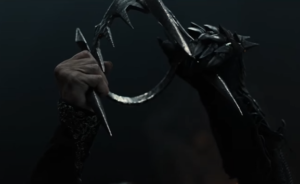

While Sauron goes to Celebrimbor and demands that he relinquish the Nine Rings, Elrond coming back from a last-resort mission to Khazad-dûm (more on that in a minute) meets up with the army of Gil-galad and leads a cavalry charge to rescue Galadriel and relieve the Siege of Eregion. I’ll let you all discover the outcome of this clash for yourselves when the episode airs, but I will say this: behind-the-scenes footage confirms that Arondir will both arrive on the battlefield at some point, and it’s strongly implied in the trailer that an army of Dwarves under Prince Durin IV will join the fray at Elrond’s behest. It’s shaping up to be a convergence of many different plotlines.


KHAZAD-DÛM
The last we saw of the Dwarves in season one, Prince Durin IV and his wife Disa had gotten just enough mithril to Celebrimbor for him to make the Three Rings, but were obstructed from mining more by Durin’s conservative father Durin III, who worried that the risk to Dwarven life and limb outweighed the benefits of helping the Elves. In season two, Celebrimbor reaches out to the younger Durin again, this time with an invitation to visit Eregion and receive a gift on behalf of all the Elves.

I suspect that by the time Celebrimbor’s letter reaches Khazad-dûm, the underground kingdom of the Dwarves will already be in danger of collapsing in on itself, making the offer of a few Rings of Power hard to resist, even for King Durin III. Furthermore, I think it’s Sauron’s doing. We see him at one point standing over a flame that he has manipulated into the shape of a Balrog, spirits of fire that long ago became beastly servants of the Dark Lord Morgoth, and over whom Sauron exercises a degree of control as Morgoth’s successor. One of the few Balrogs that survived the cataclysmic end of the First Age now hibernates deep underneath Khazad-dûm, and as Sauron prods it from afar using sorcery, its stirrings have caused the bedrock of the Dwarven kingdom to tremble.


Durin and Disa, therefore, leave for Eregion to see if Celebrimbor can be of any assistance, and discover that the Elven-smith has prepared for them seven Rings of Power, one for each of the leaders of the seven Dwarven clans (of which Durin III is one), and each one capable of slowing or reversing time like the Three. But when the Dwarves return and present the Rings to Durin III, his downward spiral into madness begins almost immediately and is noted by everyone around him, including his son and daughter-in-law.


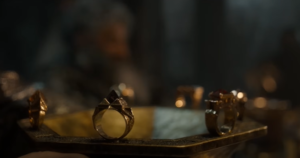
Durin III becomes afflicted with a heightened form of “dragon-sickness” that affects Ringbearers (Dwarves, canonically, much slower than other races, but I guess there’s an exception to every rule). In his paranoia, he can’t bear the thought of losing the ring and aggressively reacts to his son trying to remove it from his hand with a full-bodied slap that sends Durin IV flying, but at the same time, he seems almost eager for someone to try and take it by force, prowling around his treasury with an axe so he can assert his claim to the ring with blood.


While Disa goes spelunking in search of the root cause of Khazad-dûm’s recent troubles, Durin IV receives a visitor – Elrond, who makes a bold and desperate request of his old friend, asking for an army of Dwarves. I’m throwing out a guess here, but I think that when Galadriel and Elrond’s band of Elven warriors run into Sauron and Adar’s armies in the woods encircling Eregion, Elrond breaks away from the group and rides past Eregion to Khazad-dûm, knowing that a handful of Elves can’t possibly take on the might of Mordor alone and that Gil-galad’s armies coming down from the south will not make it to the field of battle in time. And Durin IV moves quickly, rallying the Dwarves to fight.



Since Disa isn’t standing alongside Durin IV while he’s delivering his speech to the Dwarves, she’s probably still poking around at the mountain’s roots, which can’t possibly be a good idea when a Balrog is in the vicinity. We catch a brief glimpse of the creature fully awake and enraged, wielding a sword of flame; raising the distinct and frightening possibility that Disa gets burned to a crisp. If she lives to tell the tale of what she saw (again, assuming she runs into the Balrog at all), I wonder if her efforts to stop the Dwarves from mining too deeply in search of mithril will put her in direct conflict with her husband, as he wants to supply the Elves with more mithril.
NÚMENOR
In the wake of a devastating defeat for the Númenórean ground armies in the Southlands last season, Queen-Regent Míriel and Lord Elendil weren’t expecting to be welcomed back at the end of season one by crowds cheering their names, but nothing could have prepared them for the news that Míriel’s elderly father, Tar-Palantir, had passed on in their absence, leaving his throne temporarily vacant and allowing the prospective Queen’s charismatic cousin Pharazôn to step in, ostensibly on her behalf. Míriel, dealing with the permanent loss of her eyesight, and Elendil, pushing through grief over his son’s death, must now take command of the island kingdom as it oscillates wildly between the time-honored traditions of the Faithful that have led to so many dead and wounded in a far-off land, and the aggressively isolationist policies held by Pharazôn and his followers.

In the books, it’s not a specific military blunder that causes the division, but changing Númenórean attitudes towards death – which, among the Faithful, is regarded as a gift, while Pharazôn and others like him see it as a curse, and become increasingly envious of the Elves, who enjoy immortal lives in Middle-earth and can leave at any point for the Undying Lands in the West, while mortal Men are forbidden to travel west beyond Númenor, even to visit their friends. Unfortunately, The Rings Of Power hasn’t really touched on any of these concepts, and the show – which has compressed the events of thousands of years into a few months, at most – just doesn’t have the multi-generational scope necessary to effectively convey how death gradually becomes a fixation of the Númenóreans, to the point where they are unable to find pleasure in living and can only derive transient satisfaction from taking out their fear and anger on the natural world and the native peoples of Middle-earth. This is all kind of important, though, for future storylines, so expect some mention of these things in season two.
As the rift in Númenórean society widens, even separating Elendil from his daughter Eärien, Míriel is put on trial (I think willingly) for her deeds and for her very beliefs. Her judge is to be the sea itself, or rather, what dwells within it – a tentacled leviathan that will spare her life if it finds her innocent and rip her to pieces if not. A crowd gathers to watch the ceremony, including Eärien, who makes a fateful choice to stand with Pharazôn, not her father. Whether their shocked expressions are in reaction to Míriel walking out of the water unharmed or to her mangled corpse floating to the surface is anyone’s guess.




I can’t pinpoint exactly when we see the Eagle of Manwë landing in the Court of the Kings, but I’m inclined to say that by this point Pharazôn has either declared himself King (following the results of the trial, perhaps?) or Míriel is being held in prison awaiting her trial and Pharazôn is acting again as Regent in her stead, as she is nowhere to be seen during this sequence and thematically, the arrival of an Eagle can only be interpreted as a warning from the gods that Númenor is straying down a path to certain ruin under Pharazôn’s leadership. Even Pharazôn knows that, but he also knows that many Númenóreans harbor a long-simmering resentment towards the gods (for all the reasons listed above) that they will never dare to speak aloud unless their leader does so first, and that these people are waiting with bated breath to see if he will be just another leader guided by signs and omens, like Míriel and Tar-Palantir before her. So he responds to the threat – with one of his own, brandishing his sword at the virtuous bird: a gesture of defiance which certainly won’t appease the gods, but in the short term, elicits awe from his surging supporters and fear from his opponents.
THE SOUTHLANDS
I’ve mentioned Elendil’s dead son, but of course, fans of the books and films know that Isildur – destined to play a role of singular importance in the War of the Last Alliance, still a few seasons away – didn’t actually perish in the cataclysmic eruption of Orodruin. He is, however, thousands of miles away from Númenor when he comes to in season two: and that’s not even the worst of his problems. Isildur is alone (apart from his faithful horse Berek) and surrounded by Orcs, in what was once the Southlands and is now the burnt and barren land of Mordor, where everything from the air to the local vegetation wants to kill him.

Escaping Mordor means crossing the mountain-range that forms a jagged fence along the country’s western, northern, and southern borders, in which there are only two clear points of entry – the vale of Udûn in the north, where the Black Gates will later be built, and the Morgul Pass (not yet known by that name) in the west. But as would still be the case thousands of years later when Frodo Baggins found himself stuck on the opposite side of these mountains looking for a way into Mordor, these two passes are not only known to the Orcs but frequently used by them, leaving Isildur with no choice but to attempt the treacherous Pass of Cirith Ungol dizzyingly high above the Morgul Pass: the same path, if it can even be called a path, that Frodo would ultimately be forced to take. Mordor’s Transportation Department says they’ve been meaning to get that road fixed for a while now, but I’m starting to think someone over there just enjoys diverting foot traffic into the lair of an enormous and bloodthirsty spider.
In their defense, Shelob is quite a small and bloodthirsty spider in the Second Age when Isildur runs into her. Some might even call her cute (not me, but some). Personally, I’ve never had such a visceral, full-body reaction to the creature as originally written or depicted in The Return Of The King, and I’ll explain why: Peter Jackson’s Shelob, like most “giant spiders” in fantasy, is so large that my brain doesn’t really register it as a spider, if that makes sense. I mean, I know it’s supposed to be a spider and it looks like a spider, but the size difference between spiders in the real world (the largest of which, the goliath birdeater, can grow up to 12 inches long) and Jackson’s Shelob (which is the size of a small car) is so great that I can just about turn off my arachnophobia. Not so with The Rings Of Power‘s Shelob, which, while definitely larger than the goliath birdeater, is just small enough that it’s still feasible to me. It can’t be much larger than megarachne, a prehistoric eurypterid discovered in 1980 and misidentified as a spider until 2005, that clocked in at around 21 inches long. I guess that’s how I measure a giant spider’s scariness: if I can convince myself that it or something akin to it could have existed at some point, I will never sleep again for fear that it will come back.


Evidently, Isildur escapes Shelob’s lair (Berek, on the other hand, may not be so lucky), but the land he descends into on the other side of the Mountains of Shadow is no less dangerous than the one he just left. It is here, though, that he makes some new friends, running into Arondir, a battle-hardened Silvan Elf leading the Southlander refugees who fled before Adar; Theo, an embittered young boy whose mother Bronwyn, one of the protagonists of the first season and Arondir’s love interest, has died offscreen in the intervening time because the actress, Nazanin Boniadi, left the show; and Estrid, a human woman whom we see handcuffed in some shots, suggesting that she’s either a liberated prisoner of the Orcs or a prisoner of Arondir himself, who has been said to distrust her.



As this odd little foursome moves across Middle-earth in search of a new home for the Southlanders, they encounter a number of creatures the likes of which we’ve never seen in this franchise before, including a giant centipede that tries to make a quick snack out of Estrid, and an Entwife, tall as a house, that effortlessly swats Estrid into the air (this woman cannot catch a break). What happened to the Entwives is one of Middle-earth’s greatest unsolved mysteries: long ago, in the First Age, they left the unkempt forests and built well-ordered farms and gardens in Rhovanion where they taught agriculture and horticulture to humans, but near the end of the Second Age, war swept across their lands and the Entwives vanished from history entirely. They may have been slain, or been taken captive by Sauron, or fled far east and south, into Rhûn and Harad. No one knows. Looking ahead for a moment, I almost hope The Rings Of Power doesn’t give us closure one way or another, leaving the audience with profound sorrow and a glimmer of hope to hold onto – but for now, I’m just excited to finally see an Entwife onscreen, and I would love for the show to visit their gardens in a future season.



Somehow, perhaps by hitching a ride on the Entwife’s shoulder, Arondir makes it to Eregion in time for the battle that concludes the season, but I would be surprised if Isildur, Estrid, or even Theo followed him. Their story lies in the Southlands, where the three of them will begin building something out of their weary and leaderless people; the indomitable kingdom of Gondor.
RHÛN
While Elanor “Nori” Brandyfoot and the Stranger will face countless perils in the literally uncharted land of Rhûn beyond the eastern border of J.R.R. Tolkien’s map of Middle-earth, at least their story is in no immediate danger of linking up with the central narrative. Fitting, then, that one of the first characters they’ll meet in Rhûn is Tom Bombadil, an enigmatic character best known for being so extraneous to the plot of The Lord Of The Rings that he’s been left out of nearly every adaptation of the books thus far. In all seriousness, though, Bombadil’s incompatibility with the story is deliberate: Tolkien considered him the embodiment of a “natural pacifist view, which always arises in the mind when there is a war”, someone who takes delight in “things for themselves, without reference to [him]self”, and considers “the question of the rights and wrongs of power and control….utterly meaningless….and the means of power quite valueless.”


With that in mind, something feels slightly…off about The Rings Of Power‘s take on Bombadil telling the Stranger that “Every soul in Middle-earth is in peril; will you abandon them to their doom?” I’ll reserve judgement until I hear it in its proper context, but it’s hard to imagine Bombadil saying those words in that order. This is the same person Gandalf warned would be “a most unsafe guardian” when he spoke out in opposition to a proposal put forward by the Council of Elrond to bring the One Ring to Bombadil for safekeeping. “He would soon forget it, or most likely throw it away.” And Gandalf would know: after Bombadil’s wife Goldberry and Farmer Maggot, he seems to be Bombadil’s closest friend in the books, and the Stranger in The Rings Of Power is heavily implied to be Gandalf, so there’s that.
On that note, I really don’t know how the show could get away with revealing that the Stranger is anybody other than Gandalf at this point. And I’m not just talking about his “always follow your nose” line to Nori in season one that Gandalf uses thousands of years later – also directed at a Hobbit – in The Fellowship Of The Ring. Thematically, his story is just not building towards him being Saruman, Radagast, or one of the two Blue Wizards. I do believe we’ll see these characters, most of them, arriving in Middle-earth to combat Sauron over the course of the series, but the writers chose to have the Stranger come in on a meteor specifically so he could bypass everyone and everything else, Sauron and the Elves, all of it, and land where he would be discovered, nurtured back to health, and befriended by a Hobbit. I know I’ve entertained the notion that he’s a Blue Wizard in the past, but this man is Gandalf. There’s no getting around it.

The Mystics in season one seemed to reach the same conclusion when they named him “the other”. Some took this to mean “the other” Blue Wizard, since there are two, but the full line was “He is not Sauron, he is the other”, which to me feels like another compelling argument for the Stranger being Sauron’s counterpart, the literal Enemy of Sauron, i.e. Gandalf (although I acknowledge that Saruman may have been the original Enemy of Sauron, if it was ever anything more than a title, and Gandalf may have adopted it when he “became” Saruman). Regardless, the fact that the Mystics knew in advance of both Sauron and the mysterious “other”, but had no way of distinguishing between the two until he turned on them, always implied to me that they were followers of a third and perhaps more sinister entity. Normally I’d say you know where I’m going with this, but honestly, I don’t even know if I know where I’m going with this, so bear with me.



What we know for certain is that Ciaran Hinds plays a wizard in The Rings Of Power, who appears to be the leader of the Mystics. We caught a glimpse of him in the trailer, and got a better look in a teaser posted on Twitter – and I don’t know about anyone else, but I get the distinct impression from the image above that the costume designer, hairstylists, and makeup artists were instructed to try and make Hinds pass for Sir Christopher Lee as Saruman, as he might have looked a few thousand years younger than when we met him in The Lord Of The Rings. He’s very clearly wearing off-white, which isn’t necessarily indicative of anything, but you’d think if he were a Blue Wizard, there’d be a hint of…I don’t know, blue, in his costume somewhere.
The interesting thing to consider here is that Tolkien actually sets a precedent for Saruman having traveled in the east, alongside the two Blue Wizards, in a 1954 essay published in Unfinished Tales. The Blue Wizards, according to this text, never returned, and what became of them was a mystery. In 1958, Tolkien wrote in a letter that they had likely strayed from their mission and established “secret cults and “magic” traditions” in the east. Near the end of his life, he revisited the topic, gave the Blue Wizards new names (Morinehtar and Rómestámo), and wrote that they arrived in Middle-earth much earlier than the others and were successful in undermining Sauron’s influence amongst the people of Rhûn and Harad, supporting those who rebelled against him.


I believe that The Rings Of Power is pulling bits and pieces from different versions of the story, creating a situation where Saruman and/or one of the Blue Wizards has set up a cult, while the other has stayed true and is leading the opposition to Sauron in the east. I don’t have much in the way of evidence to support this theory, but the writer in me says that if you have two characters and two equally compelling but contradictory versions of their shared storyline at your disposal, you simply adapt both versions using both characters, consequentially putting them on diverging paths, which in turn leads to more potential conflict and drama. I mean, that’s how I’d go about it.

My one concern is that Nori Brandyfoot, who was the clear protagonist of this subplot last season, will see her screentime and relevance to the story diminish as the Stranger comes into his own as a character and acquires all kinds of new powers. When the Stranger was placed among the Harfoots, and the question of how he would choose to repay their kindness was the primary source of tension, Nori’s perspective was essential as the person who took the Stranger in, vouched for him when no one else would, and had the most at stake when it was revealed to her – and the audience – if she had made the right choice. But now that we know the Stranger well enough to say with some surety that he is “good”, and with Nori and him leaving the Harfoots behind, what will she bring to the table in season two as the focus shifts to fulfilling the Stranger’s objectives?
I want to bring up showrunners Patrick McKay and J.D. Payne’s response to being asked point-blank at a San Diego Comic-Con panel if we’ll see LGBTQ+ characters on The Rings Of Power: “Maybe you have already”. Earlier at the same panel, they teased a romance involving Poppy Proudfellow; Nori’s best friend, who stopped short of joining her and the Stranger as they embarked on their adventure but works up the courage to go after them in season two. I was one of many fans who caught their breath when Poppy ran up to Nori and seemed poised to give her a kiss goodbye as they parted ways in the season finale, but I wasn’t surprised when it didn’t actually happen, because queer characters and relationships in Middle-earth has always seemed like too great an ask. I hesitate to get my hopes up even now, for fear that the showrunners were only baiting their LGBTQ+ fans, as is still so common.
And I think that just about does it for me. How did you enjoy the epic trailer out of San Diego Comic-Con, and which storylines and characters are you most excited to see when the first few episodes of The Rings Of Power season two drop August 29th? Share your own thoughts, theories, and opinions, in the comments below!
